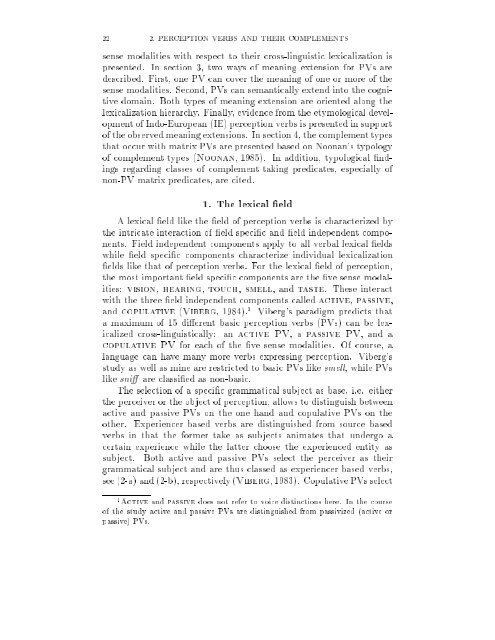Perception verb complements in Akatek, a Mayan language
Perception verb complements in Akatek, a Mayan language
Perception verb complements in Akatek, a Mayan language
Create successful ePaper yourself
Turn your PDF publications into a flip-book with our unique Google optimized e-Paper software.
22 2. PERCEPTION VERBS AND THEIR COMPLEMENTS<br />
sense modalities with respect to their cross-l<strong>in</strong>guistic lexicalization is<br />
presented. In section 3, two ways of mean<strong>in</strong>g extension for PVs are<br />
described. First, one PV can cover the mean<strong>in</strong>g of one or more of the<br />
sense modalities. Second, PVs can semantically extend <strong>in</strong>to the cognitive<br />
doma<strong>in</strong>. Both types of mean<strong>in</strong>g extension are oriented along the<br />
lexicalization hierarchy. F<strong>in</strong>ally, evidence from the etymological development<br />
of Indo-European (IE) perception <strong>verb</strong>s is presented <strong>in</strong> support<br />
of the observed mean<strong>in</strong>g extensions. In section 4, the complementtypes<br />
that occur with matrix PVs are presented based on Noonan's typology<br />
of complement types (Noonan, 1985). In addition, typological nd<strong>in</strong>gs<br />
regard<strong>in</strong>g classes of complement tak<strong>in</strong>g predicates, especially of<br />
non-PV matrix predicates, are cited.<br />
1. The lexical eld<br />
A lexical eld like the eld of perception <strong>verb</strong>s is characterized by<br />
the <strong>in</strong>tricate <strong>in</strong>teraction of eld speci c and eld <strong>in</strong>dependent components.<br />
Field <strong>in</strong>dependent components apply to all <strong>verb</strong>al lexical elds<br />
while eld speci c components characterize <strong>in</strong>dividual lexicalization<br />
elds like that of perception <strong>verb</strong>s. For the lexical eld of perception,<br />
the most important eld speci c components are the ve sense modalities:<br />
vision, hear<strong>in</strong>g, touch, smell, and taste. These <strong>in</strong>teract<br />
with the three eld <strong>in</strong>dependent components called active, passive,<br />
and copulative (Viberg, 1984). 1 Viberg's paradigm predicts that<br />
a maximum of 15 di erent basic perception <strong>verb</strong>s (PVs) can be lexicalized<br />
cross-l<strong>in</strong>guistically: an active PV, apassive PV, and a<br />
copulative PV for each of the ve sense modalities. Of course, a<br />
<strong>language</strong> can have many more <strong>verb</strong>s express<strong>in</strong>g perception. Viberg's<br />
study as well as m<strong>in</strong>e are restricted to basic PVs like smell, while PVs<br />
like sni are classi ed as non-basic.<br />
The selection of a speci c grammatical subject as base, i.e. either<br />
the perceiver or the object of perception, allows to dist<strong>in</strong>guish between<br />
active and passive PVs on the one hand and copulative PVs on the<br />
other. Experiencer based <strong>verb</strong>s are dist<strong>in</strong>guished from source based<br />
<strong>verb</strong>s <strong>in</strong> that the former take as subjects animates that undergo a<br />
certa<strong>in</strong> experience while the latter choose the experienced entity as<br />
subject. Both active and passive PVs select the perceiver as their<br />
grammatical subject and are thus classed as experiencer based <strong>verb</strong>s,<br />
see (2-a) and (2-b), respectively (Viberg, 1983). Copulative PVs select<br />
1 Active and passive does not refer to voice dist<strong>in</strong>ctions here. In the course<br />
of the study active and passive PVs are dist<strong>in</strong>guished from passivized (active or<br />
passive) PVs.

















